L.A. Noire First Look
Rockstar and Team Bondi are traveling back to the 1940s with this game's setting, but one key feature is decidedly more futuristic.
When you spend enough time watching an actor in movies or TV, you begin to pick up on subtle and telltale facial expressions--the nervous tics, the knowing grins--that are so nuanced you really only associate such looks with that actor and that actor alone. Video games aren't supposed to let you do that. Our little hobby is one that's been able to stick realistic faces onto static character models for some time now, but it has struggled mightily with showing them talk and express emotions in a way that really reflects the actors providing the voices. But apparently nobody told Rockstar that because the publisher's upcoming 1940's detective-thriller L.A. Noire uses some ambitious new image-capture technology that puts a stark focus on those sort of subtle, nuanced facial expressions to not only drive the game's story, but also the gameplay itself.

At the heart of L.A. Noire's story is protagonist and LAPD detective Cole Phelps, played by Aaron Staton. There's a good chance you'll recognize Staton from his work as account executive Ken Cosgrove on Mad Men. Like other actors in the game, Staton's dialogue performance was captured using a technology called motion scanning. It's a technique that surrounds the actor with dozens of cameras from all angles, turning those myriad shots into a composite 3D model of the character's head. Long story short, the result is a cast of characters whose faces look and move with startling similarity to their real-life counterparts. For example, diehard fans of Mad Men are likely familiar with Staton's facial expressions--things like his pursed lips and furrowed brow in moments of intense thought. Those are nuances that you'll see on the polygonal face of Cole Phelps (see the above screenshot), and it's an altogether strange sensation when you make the connection between subtleties you've picked up while watching Mad Men and a character you're seeing carry on a conversation in a video game.
Rockstar and developer Team Bondi have carried out this task--which, one imagines, must be a painfully time-consuming and expensive one--because L.A. Noire is much more of a cerebral detective game than the sandbox action fare for which the publisher is so well known. Playing as Cole, a decorated GI who has just returned home from the Pacific theatre of World War II, you'll work your way up the ranks of the LAPD one case at a time. L.A. Noire's idea of detective work places a heavy emphasis on gathering evidence and talking to suspects, witnesses, and anyone who might help you unravel the mystery at hand. Conversations with persons of interest have you navigating the murky waters of potential lies and half-truths, so it's critical that you're able to tell the difference between a genuine smile and a coy smirk when someone is giving his or her side of the story. When you combine that with a web of clues and evidence that you can refer back to in your handy notebook, you've got an idea of how the almost adventure game-like detective work functions.
To put all of this into context, Rockstar showed us one of the game's cases as played from start to (near) completion. The case began with a call to check out a traffic accident. A Chevy Styleline had veered off the road and gone crashing from an escarpment (don't be afraid to look that one up--we certainly had to). At the wheel of the car was a fairly well-known Hollywood starlet joined by an aspiring actress in the passenger seat. Examining the crashed car revealed a number of strange items that might later serve as potential clues: suspiciously torn women's underpants, a note to the aspiring actress from her parents calling for her return home, and a shrunken head clearly intended for use as a movie prop (the latter of which prompted a chuckleworthy "Alas, poor Yorick!" joke from Phelps). All of these bits of clues and evidence were then jotted down in Phelps' notebook.
After examining the wrecked vehicle, Phelps took the opportunity to chat with the well-known actress, June, who was sitting in the back of an ambulance. L.A. Noire uses a conversation mechanic that lets you decide how to respond to people's statements with multiple degrees of acceptance and empathy. You have three options for each response: believe/coax, doubt/force, and disbelieve/accuse. Knowing which of these responses to pursue is where the game's facial animations really play a critical role. After asking June whether any foul play occurred before the accident, Phelps was told that she simply lost control of the wheel--an unspectacular, everyday car accident. But the response carried an undeniable level of smugness, as did the grin on June's face afterward. This led the Rockstar reps guiding the demo to conclude that she was covering up something potentially sinister, so they accused her of lying. Any time Phelps makes such a bold claim, he has to provide relevant evidence, so in this case, Phelps brought up the torn underpants inside the car to suggest that June was hiding some sort of potentially devious conduct that led to the accident. But that's the point at which she clammed up and demanded to see her lawyer.
Phelps and his partner then hopped in a car to drive over to the hospital and question Jessica, the aspiring actress in the passenger seat who apparently suffered far worse injuries than June. This is the point in the demo at which L.A. Noire began to flash more obvious similarities to Rockstar's previous games, those open-world action games in the Grand Theft Auto mold. The game is set in what Rockstar calls a "street-for-street re-creation" of 1940's Los Angeles. Going from one scene to another, you're in full control of how you drive there, though some points in the story place a stronger sense of urgency on your travels than others. And while the game isn't as crammed with side missions and hidden entertainment as GTA or Red Dead Redemption, there are occasional opportunities to take a break from the case at hand. In one example, while driving, you might hear a call come in over the police radio to lend a quick hand with a shoot-out or a speeding vehicle.

Back on the case, Phelps arrived at the hospital to chat with Jessica. We won't spoil how to best go about prying the truth out of her, but it's clear that there are numerous ways to approach the situation rather than one "right" path toward concrete answers. But suffice it to say, the conversation with Jessica set Phelps on a far more dangerous mission than the initial traffic accident might have suggested--one filled with sexual foul play on the part of some shady Hollywood figures that seemed to confirm Phelps' initial suspicions. The remainder of the case had Phelps tailing a suspect and eavesdropping on the suspect's phone conversation, getting into a fistfight upon entering a fresh crime scene, and fleeing from goons in a high-octane car chase that left several smashed and overturned vehicles in his wake. And it all culminated in a big foot chase and shoot-out through an epic movie set, showing that the developers at Team Bondi aren't afraid to throw some straightforward third-person action into the mix to change up the pacing. Unfortunately, this was a strictly hands-off demo, so we don't know how any of it actually feels to play, but the combat looked like a solid complement to the more cerebral detective work from earlier in the demo.
L.A. Noire flashed a lot of promise with this first look. It's a game that's trying a lot of new things in the way it conveys facial expressions and then asks you to jump headfirst into understanding what they all mean. But it's also a game that seems to remember that sometimes, people just like to smash cars and shoot bad guys. Hopefully, L.A. Noire strikes the right balance between those elements. We're eager to see more leading up to the game's 2011 release date.
Got a news tip or want to contact us directly? Email news@gamespot.com
Join the conversation